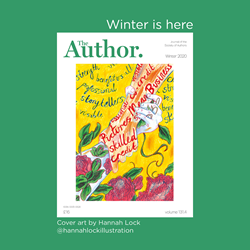 The power of collaboration
The power of collaboration
By James McConnachie
The SoA has long campaigned for proper credit to be given to a book’s illustrators. (And translators, who are equally unfairly side-lined – even relegated to parenthesis.) In November, the issue was given fresh energy by the book illustrator and designer Dapo Adeola. He was inspired to write an open letter, which attracted more than 800 authors’ signatures, after the presenters of BBC Breakfast repeatedly referred to the book he co-created with children’s author Nathan Bryon, Look Up!, as ‘Nathan Bryon’s book’.
This might have been forgivable if the book had been, say, a lengthy work of historical scholarship with an engraved frontispiece. But Adeola and Bryon conceived their book in partnership. The illustrations form an integral part of the work. It is unequivocally a co-creation. Credit is not a zero-sum game, in which the less that accrues to one party, the more that is gained by the other. No: failing to credit one artist diminishes all artists – writers included. The right of attribution is a moral right, and in more than just a technical legal sense.
Children’s book authors are mostly clued-up about giving fair credit. Adeola underlines that his writer (see what I did there?), Nathan Bryon, ‘consistently and fully supports and promotes the illustrator in this partnership’. The problem, says Adeola, lies in the media, and the book trade. He gives the example of the Sunday Times bestseller lists in which only the writers’ names feature. Less visibly, but perhaps more significantly, illustrators’ names are sometimes left off the ‘metadata’ that accompanies books, informing everything from booksellers’ websites to the crucial Nielsen Book database, which counts sales. If an author’s future depends on their sales data, as it increasingly does, then what happens to the career of an illustrator who has no visible sales data at all?
Sarah McIntyre, of the long-standing Pictures Mean Business campaign, and Woodrow Phoenix, a member of the SoA’s Management Committee, explore and explain all these matters. If the word ‘metadata’ ever filled you with unease, their specially co-created article will clarify and pacify.
This Winter issue also features another partnership of words and images: between Rose Tremain and the artist Jenny Valentine. Tremain considers how artists in different disciplines – illustration, classical music, film – have responded to her best-known novel, Music and Silence. On the art theme, we also include Carlotta Eden’s interview with Hannah Berry, the UK’s third Comics Laureate. This is to celebrate the art form (which is also unfairly side-lined, in this country at least) and to mark the launch of the SoA’s new Comics Creators Network.
The Author is always practical as well as principled, and in this Winter issue we turn to another distressingly neglected topic: that of pensions. Sanjida O’Connell considers the options available to authors in the UK, and how they compare to other European countries. Richard Houghton, meanwhile, offers a quick guide to data protection law – which, you may be surprised to learn, could well affect you. The distinguished public health expert, Anthony Kessel, offers advice – compassionate, thoughtful, practical advice – on coping with uncertainty in the midst of a pandemic.
 Editors should never pick favourites but one article in this issue stands out, even though it is only half a page long. It highlights the difference the SoA makes, and the seriousness of what is at stake. Poet C.M. Buckland describes how receiving a grant from the Authors’ Contingency Fund helped give her the strength to keep going. If you are able to make a donation to the Contingency Fund, please get in touch. If you need assistance from the Contingency Fund, the message is precisely the same: please get in touch. We are all in partnership with each other now.
Editors should never pick favourites but one article in this issue stands out, even though it is only half a page long. It highlights the difference the SoA makes, and the seriousness of what is at stake. Poet C.M. Buckland describes how receiving a grant from the Authors’ Contingency Fund helped give her the strength to keep going. If you are able to make a donation to the Contingency Fund, please get in touch. If you need assistance from the Contingency Fund, the message is precisely the same: please get in touch. We are all in partnership with each other now.
James McConnachie
mcconnachie.tumblr.com | @j_mcconnachie
Cover artwork by Hannah Lock
Hannah Lock is a freelance illustrator from Huddersfield, West Yorkshire. She studied at the Cambridge School of Art and works with coloured pencils. She’s previously worked with clients such as the Brontë Parsonage Museum, Catapult publishing and Oh magazine.
hannahlock.com | Instagram: @hannahlockillustration | Twitter: @hannahlock
In this issue
CO-CREATORS
The data dive – By Sarah McIntyre and Woodrow Phoenix
A seat at the table – Save a space for comics creators, says Hannah Berry
Music and silence; darkness and light – Rose Tremain on artistic adaptions
Q&A: Hannah Lock – This issue’s cover artist
FEATURES
Breaking ground – Sharmilla Beezmohun introduces Speaking Volumes
Author pensions – All you need to know, by Sanjida O’Connell
Tea towels and bloodied waistcoasts – The legacy of writers’ homes, by Caroline Brothers
Q&A: Lemn Sissay – BAFTA-nominated poet and playwright
AUTHOR LIFE
Changing the story – A space for working-class writers, by Natasha Carthew
In short order – The order of your short stories is crucial, says Dan Brotzel
Writing with MS – Helen Fowler on writing and living with MS
Data protection for authors – A beginner’s guide, by Richard Houghton
The (awareness of) uncertainy pandemic – Coping in the time of Covid, by Anthony Kessel
Building resilience – C.M. Buckland on help from the Authors’ Contingency Fund
Grub Street – Andrew Taylor’s quarterly digest
FROM THE SOA
News – A look ahead, Audible, Translation Prizes & more
Spotlight: SoA groups and networks – Latest activities and events
Letters to the Editor
Welcome, new members
Services for authors